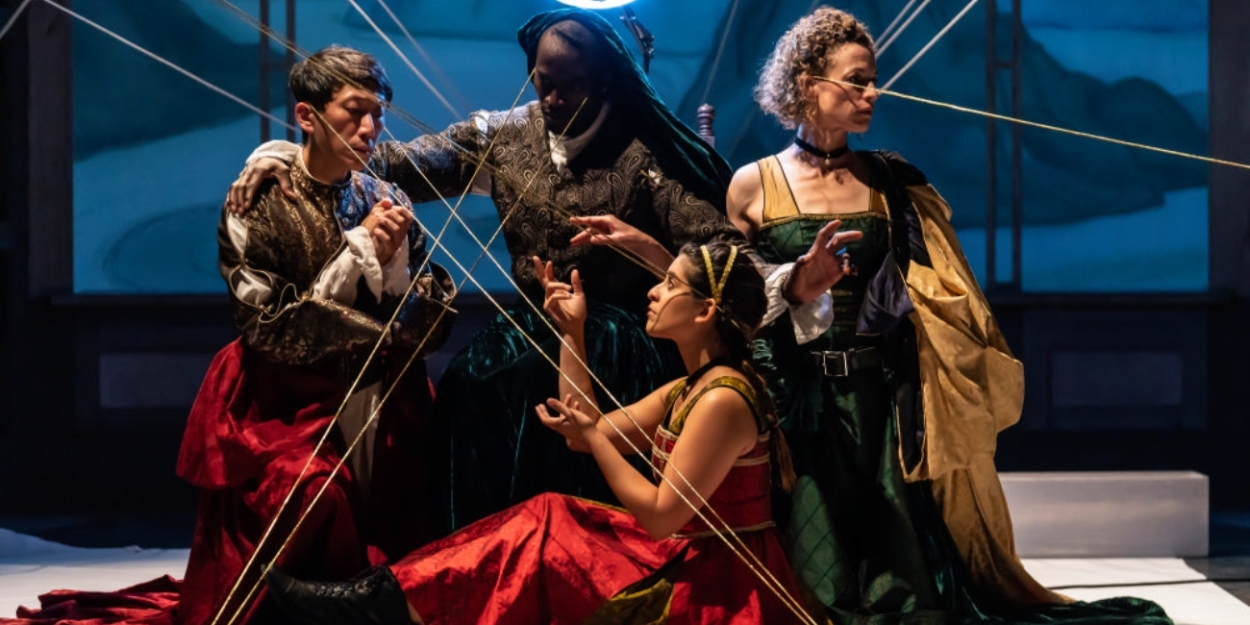Review: THE NOTEBOOKS OF LEONARDO DA VINCI at Shakespeare Theatre Company
Renaissance wisdom comes alive in a dazzling production

Leonardo Da Vinci predated William Shakespeare by half a century; their paths never crossed. Both were artists who changed the world with their vision; each had flinty intellects interested in a wide variety subjects that the Renaissance opened up to them. And while the Bard had a superior command of words - it was his stock in trade, after all; Da Vinci still had a poetic approach to the words he wrote down mostly to keep track of what he was learning as he went along - about art, figure study to physiology to flight.
It's fitting, then, that Mary Zimmerman's "The Notebooks of Leonardo Da Vinci" is being presented at the Shakespeare Theatre Company, where previously she's directed some striking work, including "Pericles, Prince of Tyre" in 2004 and "Argonaulika" in 2008.
As important as they are, Da Vinci's notebooks weren't assembled until long after the artist's death in 1519. Putting together the lists, ideas, artistic doodles, declarations and spookily futuristic Renaissance thoughts into published form didn't occur until 1632, but new editions in ensuing centuries added previously unknown pieces, including a previously unknown manuscript discovered in Spain in 1965.
Forgive him for not having time to organize the 5,000 pages of missives, reciepts and scraps of paper in his own lifetime. He might have been too busy creating the Mona Lisa or "The Last Supper" or the exquisite "Ginevra de' Bence" that can be seen blocks away at the National Gallery of Art (the only Da Vinci in the Americas). The polymath Florentine also spent his time as sculptor and scientist - even before that was even a term.
The bits of genius from his notebooks could easily command a stage with just reading (there is already a podcast of them). Or, Zimmerman could have highlighted her favorite parts with slides, TED talk-style, as she did about the metamorphosis of poetry at a Chicago event in 2013.
Instead, the notebooks become a template for theater nearly as imaginative and bold as the original texts themselves - or certainly worthy of them.
Zimmerman's remarkable "The Notebooks of Leonardo Da Vinci," first presented in 1993, is one of her earliest works, before she'd go on to win a Tony for directing her hit adaptation of Ovid's "Metamorphoses."
In what can only be described as an optimum synergy between actors, text, scenery and stagecraft, Da Vinci's works take flight like the wings of the flying machine he once imagined. The 90-minute piece is bracketed by a visit Da Vinci imagines he had in the cradle from a falcon - and again late in life.
It moves to a series of still-solid rules about artistic approaches, variations of positions (18) and rules of thumb for proportions (not all of which measure up as when one man's wingspan turns out not to equal his height).
On a terrific set by Scott Bradley that consists of sky-high wooden files, as if a magical curio cabinet where this wisdom is reposited, each of the actors, one by one, speak the words of Da Vinci (each, then, is credited as "Leonardo" in the abbreviated theater program). Behind them, the aphorisms are interpreted through movement in such a way that it often resembles dance.
From an anatomy comes the study of the muscles and tendons beneath - knowing how they work can only enhance their replication in art. But beyond that - isn't it interesting what the human body is made of? Then comes a pantomime of cutting into corpses to see what's what and where.
The drawers along the side are pulled out, they may show their own tableau or diorama of what's being discussed, or they may just be perches for other actors to rest. One held sloshing water in glass; another a rows of wheat. One dazzling set piece sets up the stage in string to demonstrate the properties of perspective.
As enriching as all of this is and as terrific as it all is to experience, the individual segments are still minus that other important elements of the theater: story, character development, or other demonstrations of relationships that could build or shift through the performance, or otherwise engage the audience.
On the other hand it makes the accomplished cast an ensemble of acrobatic equals that few other productions can boast. They are: Christopher Donahue, Kasey Foster, John Gregorio, Anthony Irons, Louise Lamson, Andrea San Miguel, Wai Yim and Adeoye.
The original music that occasionally swells, from sound designer Michael Bodeen and Miriam Sturm, is effective, though prerecorded. The lighting by T.J. Gerckens risies to the challenges of the marvelous set and the costuming by Mara Blumenfeld only enhances the movement and visual splendor.
The intent of the evening is not to directly inspire everyone to go out and become an artist (though the thought does arise). Instead, it's to instill in viewers the kind of wonder that was the basis of how Da Vinci's experience with the world.
Photo credit: Wai Yim, Adeoye, Louise Lamson, and Andrea San Miguel in "The Notebooks of Leonardo da Vinci." Photo by Scott Suchman.
Running time: About 90 minutes, with no intermission.
"The Notebooks of Leonardo Da Vinci," adapted and directed by Mary Zimmerman, continues through Oct. 23 at the Shakespeare Theater Company Klein Theatre, 450 7tth Street NW. Masks are required for the audience. Tickets from 202-547-1122 or online.
Reader Reviews

Videos

